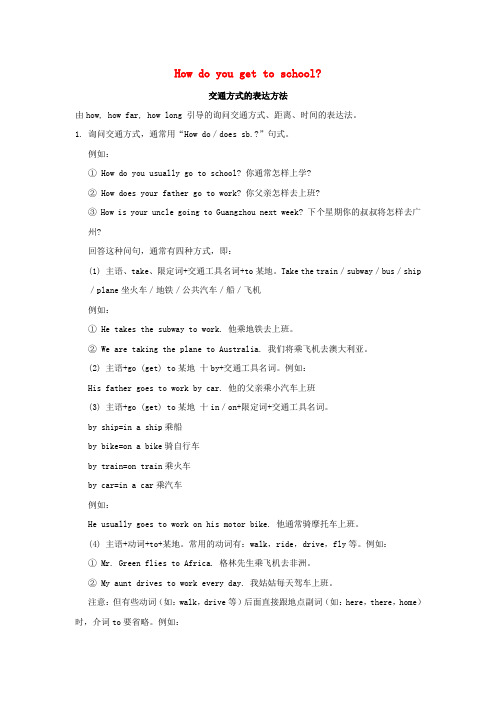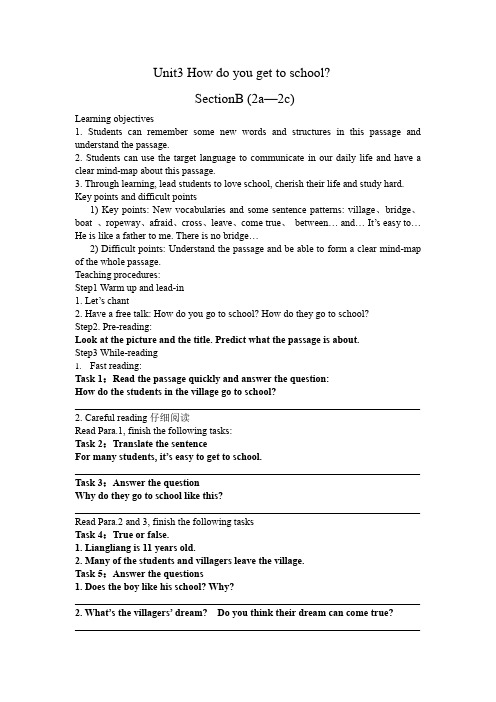Unit 3 How do you get to school(整单元课件)9
- 格式:ppt
- 大小:3.73 MB
- 文档页数:28

How do you get to school? 要点详解1. —How does Bob get to school? 鲍勃怎样到校的?—He takes the train. 他乘火车。
① how意为“如何”,常用于对“做某事”的方式提问。
② take在这里是“乘坐(交通工具)”的意思。
例如:take the subway乘地铁take the bus乘公共汽车take the train乘火车take a taxi乘出租车take a boat乘船[归纳] take可以与其他词连用,表示“吃;喝;享受;得到;享有”等意义。
例如:take a holiday/a walk/a bath/a quick look around/a deep breath ∕ a seat /a photo休假/散步/沐浴/迅速向四周望一眼/深呼吸/坐/照相2. “交通方式”的多种表达①英语中常用"How do/does sb....?"对交通方式提问。
例如:How do you get to school? 你怎样去学校?②表示交通方式可以用动词take (意为“乘……”)或ride与交通工具一起构成动词短语,在句子中充当谓语。
例如:take the train/subway/bus/ship/plane坐火车/地铁/公共汽车/船/飞机,ride a bike/horse骑自行车/骑马;表示交通方式还可以由介词“by十交通工具”或“on/in(a)+交通工具来表示。
例如:by ship=in a ship乘船by bike=on a bike骑自行车by train=on train乘火车by car=in a car乘汽车③常见的“交通方式”表达有:by bus乘公共汽车by train乘火车by ship/sea乘船by plane/air乘飞机by bike骑自行车by car乘小汽车on foot步行go to…by car=drive to…go to…by bike=ride to…go to…on foot=walk to…go to…by plane/air=fly to…3. It takes about forty minutes. 大约花费40分钟。

How do you get to school?交通方式的表达方法由how, how far, how long 引导的询问交通方式、距离、时间的表达法。
1. 询问交通方式,通常用“How do/does sb.?”句式。
例如:① How do you usually go to school? 你通常怎样上学?② How does your father go to work? 你父亲怎样去上班?③ How is your uncle going to Guangzhou next week? 下个星期你的叔叔将怎样去广州?回答这种问句,通常有四种方式,即:(1) 主语、take、限定词+交通工具名词+to某地。
Take the train/subway/bus/ship/plane坐火车/地铁/公共汽车/船/飞机例如:① He takes the subway to work. 他乘地铁去上班。
② We are taking the plane to Australia. 我们将乘飞机去澳大利亚。
(2) 主语+go (get) to某地十by+交通工具名词。
例如:His father goes to work by car. 他的父亲乘小汽车上班(3) 主语+go (get) to某地十in/on+限定词+交通工具名词。
by ship=in a ship乘船by bike=on a bike骑自行车by train=on train乘火车by car=in a car乘汽车例如:He usually goes to work on his motor bike. 他通常骑摩托车上班。
(4) 主语+动词+to+某地。
常用的动词有:walk,ride,drive,fly等。
例如:① Mr. Green flies to Africa. 格林先生乘飞机去非洲。
② My aunt drives to work every day. 我姑姑每天驾车上班。


人教版(新目标)初中英语七年级下册Unit3Unit3 How do you get to school?Unit3 知识梳理◆短语归纳1. get to school 到达学校2. take the subway 乘地铁3. ride a bike 骑自行车4. how far 多远5. from home to school 从家到学校6. every day 每天7. take the bus 乘公共汽车8. by bike 骑自行车9. bus stop 公共汽车站10. think of 认为11. betweenand 在和之间12. one 11-year-old boy 一个11岁的男孩 13.play with 和玩14. come true 实现15. have to 不得不◆用法集萃1. taketo= go toby 乘去2. How do/does sb get to? 某人是怎样到的?3. How far is it fromto? 从到有多远?4. It takes sb. some time to do sth. 做某事花费某人多长时间。
5. How long does it take to do sth.? 花费多长时间?6. It is + adj. + to do sth. 做某事是7. Thanks for + n./Ving 感谢你(做)某事。
◆典句必背1. How do you get to school? 你怎么去上学?I ride my bike. 我骑自行车。
2. How far is it from your home to school? 从你家到学校有多远?3. How long does it take you to get to school? 去上学花费你多久?4. For many students, it is easy to get to school. 对很多学生来说,很容易到达学校。

Unit 3 How do you get to school适用年级七年级所需时间5课时主题单元学习概述本单元话题取材于七年级英语下学期第三单元:交通运输方式。
该话题与学生生活息息相关,他们有深刻的生活体验,易于接受,有话可说,乐于表达。
本单元以交通为话题、以谈论出行方式为功能,在具体语境中呈现了How、How far、How long 引导的特殊疑问句及回答,谈论如何到达目的地、行程多久及距离多远。
本单元包括33个生词和9个常用短语和固定搭配。
通过模仿对话、自编对话、阅读,学生将掌握不同交通方式的英语表达,了解不同地区的学生是采用何种交通方式去学校的,并能根据自己实际情况,合理安排行程,合理选用交通工具。
主题单元规划思维导图主题单元学习目标知识与技能:1.能听说读写围绕交通工具等的核心词汇。
2. 能正确使用各种人称来询问他人的出行方式,并作出正确地回答。
3.能在任务型活动中熟练运用how, how long, how far等引导的特殊疑问句询问出行方式、所花费时间和两地之间的距离。
过程与方法:1.通过谈论不同的上学出行方式,提高同学们的口语表达能力和交际能力。
2.在多媒体资源和网络资源的帮助下,锻炼听说读写能力。
3.使用阅读技巧阅读文章,提高阅读理解能力,培养寻找信息,概括主旨大意的能力。
4.能够写一篇电子邮件来介绍自己的出行方式。
情感态度与价值观:1.让学生了解东西方国家出行方式的区别,以及不同的交通规则,教育学生注意交通安全。
2.通过英美国家交通文化的学习,倡导自觉遵守交通法规及礼貌,构建和谐的人际关系。
对应课标1.能听懂有关出行话题的对话,提取重要信息和观点。
2.能熟练使用语言目标有效地询问信息和获得帮助。
3.能在活动中正确地使用语音、语调。
4.能在课文中找出有关信息,理解课文大意。
5.在交际中遇到困难时,能主动地向老师和同学寻求帮助。
6.能主动参与小组学习,并在小组活动中扮演一定的角色。

Unit3 How do you get to school?SectionB (2a—2c)Learning objectives1. Students can remember some new words and structures in this passage and understand the passage.2. Students can use the target language to communicate in our daily life and have a clear mind-map about this passage.3. Through learning, lead students to love school, cherish their life and study hard. Key points and difficult points1) Key points: New vocabularies and some sentence patterns: village、bridge、boat 、ropeway、afraid、cross、leave、come true、between… and… It’s easy to… He is like a father to me. There is no bridge…2) Difficult points: Understand the passage and be able to form a clear mind-map of the whole passage.Teaching procedures:Step1 Warm up and lead-in1. Let’s chant2. Have a free talk: How do you go to school? How do they go to school?Step2. Pre-reading:Look at the picture and the title. Predict what the passage is about.Step3 While-reading1.Fast reading:Task 1:Read the passage quickly and answer the question:How do the students in the village go to school?_____________________________________________________________________ 2. Careful reading仔细阅读Read Para.1, finish the following tasks:Task 2:Translate the sentenceFor many students, it’s easy to get to school._____________________________________________________________________ Task 3:Answer the questionWhy do they go to school like this?_____________________________________________________________________ Read Para.2 and 3, finish the following tasksTask 4:True or false.1. Liangliang is 11 years old.2. Many of the students and villagers leave the village.Task 5:Answer the questions1. Does the boy like his school? Why?_____________________________________________________________________ 2. What’s the villagers’ dream? Do you think their dream can come true?_____________________________________________________________________3.Discussion(讨论)How can their dream come true?What can we do?What can they do?Their dream can come true if(如果) people around the world(世界各地的人们)help them.By discussing the answers of the questions, it can improve their ability of cooperation.4. Read the passage again. Complete the sentences with the words from the passage.1) For the students in the village, it is ________ to get to the school.2) They have to cross a very _____ river between their school and the village.3) They cannot go by boat because the river runs too _________.4) It is not easy to cross the river on a ropeway, but the boy is not _______.5) The students and villagers want to have a bridge. Can their dream come _____? 5. ListeningListen and repeat, try to imitate the pronunciation and intonation.Step4.Post-reading:Retell the whole passage according to the mind-map.For many students-----It’s easy to get to schoola big river between…difficult no bridge so……For the students inone small village the river runs quicklyone 11-year-old boyLiangliangis is not afraidloves schoolDream------have a bridge-----come trueRewritingComplete the passage without looking at your own books.Life is precious(宝贵的). We should cherish our good life now.(珍惜现有的生活)Step7.Homework1. For all: Finish the exercise and preview 3a and 3b.2. Optional: Write a letter to the village students and tell them the way you get to school and what you want to do for them.Unit 3 How do you get to school?学情分析Section B (2a-2c)七年级下册教材内容,较七年级上册内容比,英语知识点深入,而且我们这里的学生地处比较偏远的农村地区,各种条件相对比较落后。